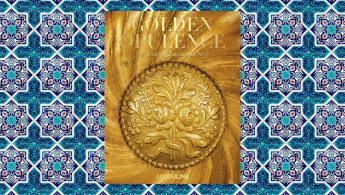Golden Opulence: Ottoman grandeur and 500 years of luxury
Assouline's latest release, Golden Opulence: 500 Years of Luxuriant Style, is a challenge to summarise. While its core idea is straightforward, the book's contents are rich and almost beyond description, encompassing both historical and contemporary luxuries. It illustrates that luxury is not a modern invention but has roots as ancient as civilizations; in this case, Ottoman.
Marking its 50th anniversary, Beymen, a renowned Turkish department store, orchestrated a magnificent celebration of luxury. This event invited designers and artisans worldwide to draw inspiration from the opulent history of Ottoman art and culture.
Over 50 designers converged in Istanbul for the "Golden Opulence" exhibition, showcasing their creations at the Tophane-i Amire, a 15th-century Ottoman factory now serving as a culture and art centre.
Assouline, as the official publisher of this exhibition, has compiled a stunning collection of images. This collection beautifully contrasts the grandeur of Ottoman heritage with contemporary designs inspired by that very splendour.
"This book is a remarkable gift to art enthusiasts, masterfully showcasing not only beauty but also enlightening readers on the historical exchanges that have continually influenced and redefined visual delights"
Ottoman opulence, a fitting era
The art and architecture of the Ottoman era provide a vivid and inspiring canvas for any artist. Take, for instance, the Blue Mosque's ceiling, with its ingeniously supported domes and a plethora of colourful windows that bathe the interior in sunlight.
Equally mesmerising is the Green Mosque of Bursa. The mihrab's moulded tile frame and niche, crowned by twelve rows of muqarnas — an ornamented vaulting — with a six-ribbed shell on top, are symbolic of the intricate beauty and craftsmanship of the era.
Such remarkable artistry is undoubtedly inspiring; to remain unmoved by it suggests a disconnection from artistic passion. The extravagant luxury of the past is nearly inimitable, yet the products it inspires are nonetheless remarkable.
The dome-rings by Turkish designer Sevan Bicakci, adorned with Ottoman motifs, are a noteworthy highlight.
Yet, some contributions to the collection lean towards the ordinary. For instance, the Italian brand Golden Goose Deluxe Brand offered burgundy suede sneakers with studded and laminated gold leather heels, a style that, while potentially striking on celebrities like Drake, exemplifies how luxury is often diluted by dressing up streetwear. This trend is mirrored in an Off-White sports jacket adorned with floral motifs, representing the fusion of sportswear with luxury fashion.
In contrast, Balmain's contribution stands out for its sheer dazzle. The multicoloured crystal-studded dress, complete with a matching hat and slippers, is a testament to Olivier Rousteing's commitment to embodying Ottoman artistry.
Rousteing said, “I have channelled the renowned splendour of the finest Ottoman artists, with Turkiye’s rich heritage reflected in the capsule’s incredible fabrics, beads, jewels, and embroideries.” This piece is so striking that it's easy to picture someone like Beyonce wearing it.
Alexander McQueen's contribution, a handbag with a goldwork knuckle clutch and intricate bullion and sequin embroidery, epitomises a blend of luxury and the detailed essence of Ottoman art. Similarly, Sergio Rosso's gold leather sandals, inspired by an imperial fan and adorned with feathers, are a fine example of elegance and historical inspiration.
This collection beautifully illustrates how the past continues to inspire contemporary designers, who often turn to the old-world masters for guidance. Turkish influences, however, are not a novel concept in design.
Ottoman Turkey: Between East and West
The journey from the Ottoman Empire to the present exhibition is enriched with earlier examples of Western adaptation of Ottoman art. The book highlights notable pieces like a 1924 Cartier vanity case and a 1937 tiara from the same luxury house, featuring the iconic Inzik-colour and tulip motifs characteristic of Ottoman art.
Among the most stunning pieces is Ann Getty’s canopied bed, a design inspired by a Turkish throne, so exquisite that it seems almost a shame to relegate such beauty to a bedroom setting.
The text in the book provides an intricate account of both history and the exhibition, delving into how the Ottoman fleet's winter docking in 1543 in southern France sparked the 'à la Turque' style.
This emergence of Turkish influence in European fashion and design was more than a mere consequence of idle ships. It was partly fueled by the alliance between French King Francis I and Ottoman Sultan Suleiman the Magnificent, united against their common enemy, Charles V of Spain.
Francis I's admiration for Moorish bracelets from Turkiye is noted, and the book describes how Turkish fashion influenced the attire of dancers at the wedding of his niece.
This cultural exchange extended to French literature, with writers like Racine and Moliere portraying the Ottoman world in their works. During the Enlightenment, Parisian boudoirs began incorporating fabrics from Ottoman harems, and flywicks started to replace traditional fans.
Even Marie Antoinette's Turkish boudoir was adorned with bronze crescent moons, and oushak rugs with medallions decorated the court's rooms. The book illustrates how Turkish cultural elements like sofas, ottomans, shalwars (baggy pants), and more, began to permeate and influence European fashion and interior design.
This book is a remarkable gift to art enthusiasts, masterfully showcasing not only beauty but also enlightening readers on the historical exchanges that have continually influenced and redefined visual delights.
Having reviewed numerous Assouline publications over the years, I find this particular book to stand out as my favourite. Its absolutely beautiful collection makes it a true joy to behold, offering a veritable feast for the eyes.
Khelil Bouarrouj is a Washington, DC-based writer and civil rights advocate. His work can be found in the Washington Blade, Palestine Square, and other publications

!["The history of luxury is as old as the history of humanity" [Assouline]](/sites/default/files/2024-02/thumbnail_Outlook-image0.jpe_.jpg)
![Five centuries of luxury have continuously evolved, inspiring the present day [Assouline]](/sites/default/files/2024-02/thumbnail_Outlook-image4.jpe_.jpg)


